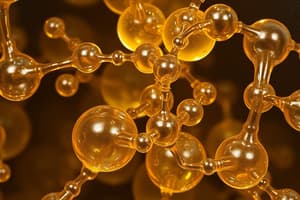Podcast
Questions and Answers
What is the primary difference between addition polymerization and condensation polymerization?
What is the primary difference between addition polymerization and condensation polymerization?
- Addition polymerization involves shaping plastics through crosslinking bonds, while condensation polymerization forms tangled polymer chains.
- Addition polymerization forms polymers by coupling monomers through multiple bonds, while condensation polymerization joins two molecules by elimination of a small molecule. (correct)
- Addition polymerization forms hard plastics, while condensation polymerization forms soft plastics.
- Addition polymerization involves reshaping polymers using heat and pressure, while condensation polymerization involves irreversible chemical processes.
Which type of plastics can be reshaped with the application of heat?
Which type of plastics can be reshaped with the application of heat?
- Plastics with strong covalent crosslinking bonds.
- Plastics that remain hard when heated.
- Plastics with tangled (no cross-links) polymer chains. (correct)
- Plastics with weak forces of attraction between chains.
In condensation polymerization, how are two molecules joined to form a larger molecule?
In condensation polymerization, how are two molecules joined to form a larger molecule?
- Through the application of heat and pressure.
- By coupling monomers through multiple bonds.
- By reshaping the molecules using heat.
- By eliminating a small molecule like H2O. (correct)
What are non-reshapeable plastics characterized by?
What are non-reshapeable plastics characterized by?
What is the purpose of numbering plastics from 1 to 7 according to their type?
What is the purpose of numbering plastics from 1 to 7 according to their type?
Which type of plastics cannot be reshaped readily?
Which type of plastics cannot be reshaped readily?
What type of polymers are specifically made of carbon atoms bonded together into long chains?
What type of polymers are specifically made of carbon atoms bonded together into long chains?
Which of the following is an example of a natural polymer?
Which of the following is an example of a natural polymer?
What process is used to produce synthetic polymers like epoxy and polyester?
What process is used to produce synthetic polymers like epoxy and polyester?
Which type of polymer is Teflon an example of?
Which type of polymer is Teflon an example of?
Which property of polymers is related to their ability to act as effective insulators against heat flow?
Which property of polymers is related to their ability to act as effective insulators against heat flow?
Which property of a polymer describes the extent to which the polymer chains are arranged in a regular structure?
Which property of a polymer describes the extent to which the polymer chains are arranged in a regular structure?
Which type of polymer is typically used to wrap foods because it is less permeable to oxygen than polystyrene?
Which type of polymer is typically used to wrap foods because it is less permeable to oxygen than polystyrene?
Which property of a polymer describes the force required to stretch the plastic in one direction?
Which property of a polymer describes the force required to stretch the plastic in one direction?
Which property of a polymer describes the strength of the plastic, or the force that must be applied in one direction to stretch the plastic until it breaks?
Which property of a polymer describes the strength of the plastic, or the force that must be applied in one direction to stretch the plastic until it breaks?
Which property of a polymer describes the ability of the plastic to resist abrasion and wear?
Which property of a polymer describes the ability of the plastic to resist abrasion and wear?
Which property of a polymer describes the extent to which the plastic affects light as it passes through the polymer?
Which property of a polymer describes the extent to which the plastic affects light as it passes through the polymer?
Flashcards are hidden until you start studying
Study Notes
Addition Polymerization vs. Condensation Polymerization
- Addition polymerization involves monomers adding to each other without the loss of any atoms.
- Condensation polymerization involves monomers joining together, releasing a small molecule (like water) in the process.
Reshapeable and Non-Reshapeable Plastics
- Thermoplastics can be reshaped with heat, as they soften when heated and solidify upon cooling.
- Thermosets are non-reshapeable plastics, as the cross-linking between polymer chains prevents them from softening upon heating.
Condensation Polymerization Process
- Two molecules join to form a larger molecule, releasing a small molecule like water as a side product.
Non-Reshapeble Plastic Characteristics
- Non-reshapeable plastics are characterized by having strong cross-linked polymer chains, which prevent the chains from moving freely.
Purpose of Numbering Plastics
- Plastics are numbered from 1 to 7 according to their type to help consumers understand the type of resin used for recycling purposes.
Plastics that Cannot be Reshaped
- Thermosets like epoxy, polyester, and polyurethane cannot be reshaped readily.
Carbon Chain Polymers
- Hydrocarbons are polymers specifically made of carbon atoms bonded together into long chains.
Natural Polymers
- Cellulose, one of the most abundant organic compounds, is an example of a natural polymer.
Synthetic Polymer Production
- Synthetic polymers like epoxy and polyester are produced by polymerization reactions.
Teflon Polymer Type
- Teflon is an example of a fluoropolymer.
Polymer Insulator Property
- Low thermal conductivity is the property that enables polymers to act as insulators against heat flow.
Polymer Crystallinity
- Crystallinity describes the extent to which the polymer chains are arranged in a regular structure. Higher crystallinity generally leads to greater strength and rigidity.
Packaging Polymer
- Polyethylene is a polymer that is commonly used to wrap foods because it is less permeable to oxygen than polystyrene.
Stretching Force
- Tensile strength describes the force required to stretch the plastic in one direction.
Breaking Force
- Ultimate tensile strength describes the strength of the plastic, or the force that must be applied in one direction to stretch the plastic until it breaks.
Abrasion Resistance
- Abrasion resistance refers to the ability of the plastic to resist abrasion and wear.
Light Transmission
- Transparency describes the extent to which the plastic affects light as it passes through the polymer.
Studying That Suits You
Use AI to generate personalized quizzes and flashcards to suit your learning preferences.




